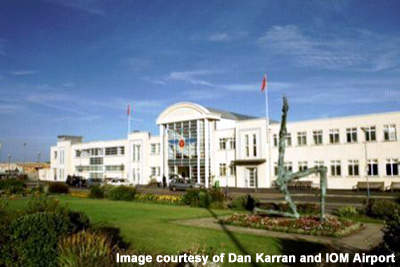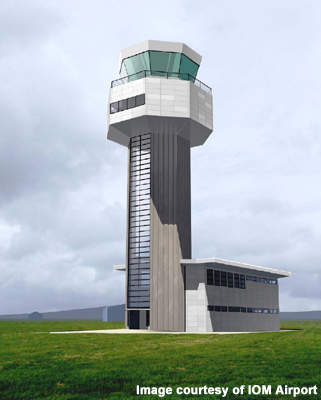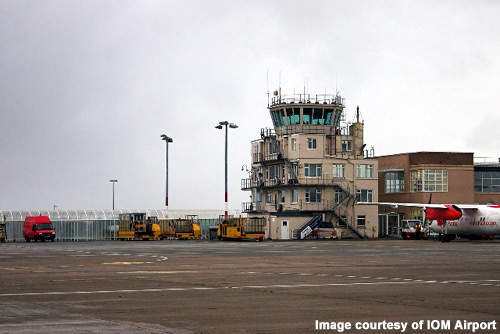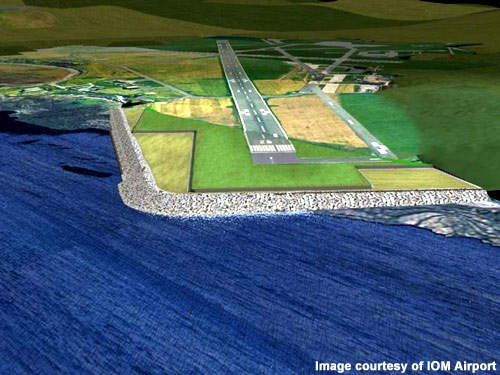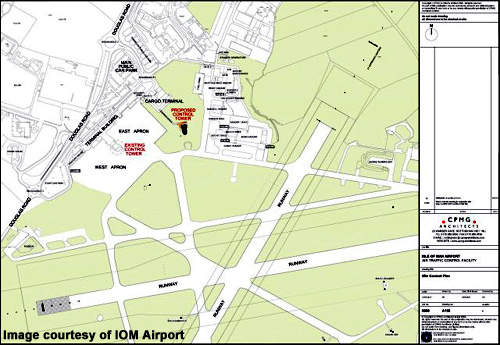Isle of Man Airport, which is also known as Ronaldsway Airport, is the major domestic airport on the Isle of Man (first used for commercial flights in 1929). The airport is situated in the south of the island at the ex-RAF base Ronaldsway between Ballasalla and Castletown, which is about 11km southwest of the island capital Douglas.
The airport runs commercial scheduled services to the United Kingdom, Republic of Ireland and the Channel Islands. The airport is operated by the Isle of Man Department of Transport under the direction of the Tynwald (IoM parliament).
The airport has two runways the 08/26 (5,754ft, 1,754m) main runway and the 03/21 secondary runway (3,934ft, 1,199m) and serves around 700,000 passengers a year – 2007 saw 753,894 passengers, a 4% reduction on the 2006 total of 785,042.
Isle of Man Airport expansion
The airport has already benefitted from an expansion programme begun in 1998, which improved the terminal building (originally built in 1952) by increasing passenger facilities such as a new landside restaurant, arrivals area, baggage hall and departure lounge (designed by Ellis Brown Architects and opened in March 2000).
This project also improved the check-in facilities, airport offices and the front entranceway as well as refurbishing the symbolic Three Legs of Mann sculpture on the airport external façade. A further project in March 2006 increased the number of departure gates and improved the departure lounge and this was completed in May 2007 by Parkinson for £1.54m.
Runway expansion
In April 2008, following a planning enquiry, the Tynwald granted a major runway extension and resurfacing project at the IoM airport. The design involves extension of the main runway and incorporation of additional runway safety areas (RESAs). The main runway will be extended by 245m (804ft) out into the Irish Sea by the construction of a reclaimed rock-armoured strip of land.
The project is part of a £44m plan which will include the resurfacing of the runway during the summer of 2008 and the extension project, which began in spring 2008 being completed by December 2009. Contractors include Carillion for the extension with proposals developed by Carillion Business Services' design and project management division TPS. Faber Maunsell AECOM is environmental consultant and ChandlerKBS is cost management consultant.
The runway will not be used for heavier aircraft but is to bring the airport into compliance with international regulations. During the extension project earthworks a Bronze Age village was discovered, which has given archaeologists much information on island life from over 3,500 years ago.
New airport control tower
Another current project for the airport is the construction of a new control tower. The funding for the project was sought in July 2008 from the Tynwald and was granted. The work started in August 2008.
The old tower was outmoded for modern transport needs and was only 19m high. Ann Reynolds, the airport director, explained the problem: "The existing control tower is located centrally within the main apron aircraft parking area and while this location has advantages in respect of apron oversight, it has two fundamental disadvantages.
"First, the building is located closer to the 08 threshold (touchdown point at the western end of the airfield), whereas the majority of traffic uses 26 (eastern end of the airfield). Second, it has no direct view of the 21 threshold (northern touchdown point of the secondary runway), which currently relies on a camera to help ensure that the runway is not obstructed."
The new tower project will cost £6,515,000, be built east of the existing tower, and is expected to have construction completed by November 2009 and be operational by the first quarter of 2010. The building will contain aerodrome control, approach radar control, avionics equipment room, avionics equipment workshop, training room, briefing room, offices, main plant, aeronautical ground lighting (AGL) equipment room and staff welfare facilities.
The construction of the new 35.3m tower alone will cost £3.85m and the avionics for the equipment will cost £1.8m; the remaining £0.86m ancillary costs are for professional fees, commissioning and site supervision.
The designers are CPMG Architects of Nottingham and the avionics equipment will be procured, installed and commissioned by National Air Traffic Services (NATS) as its commercial arm NSL (NATS Services Ltd), in compliance with the regulatory requirements of the Safety Regulation Group of the Civil Aviation Authority. The main contractor is Parkinson Limited.

